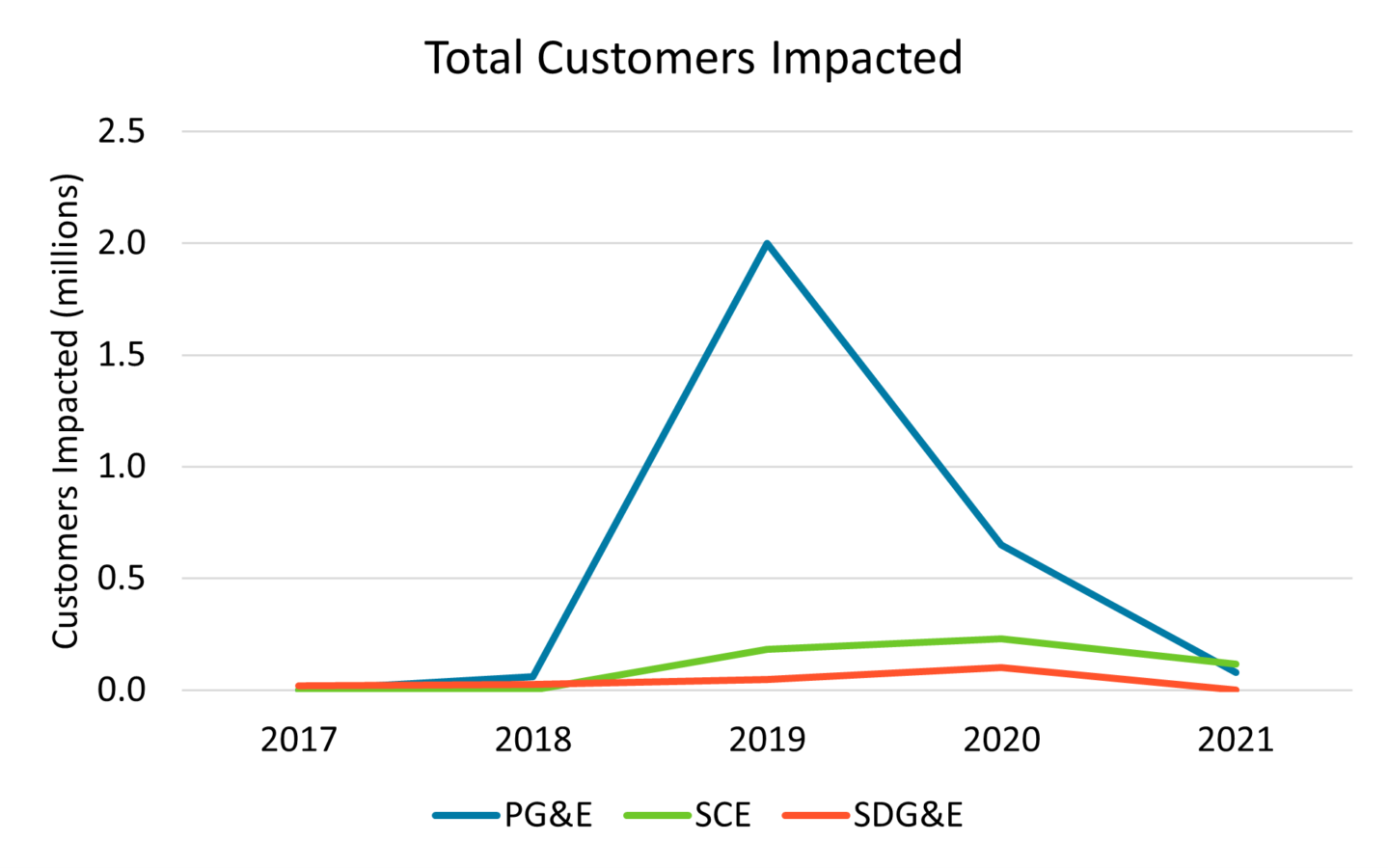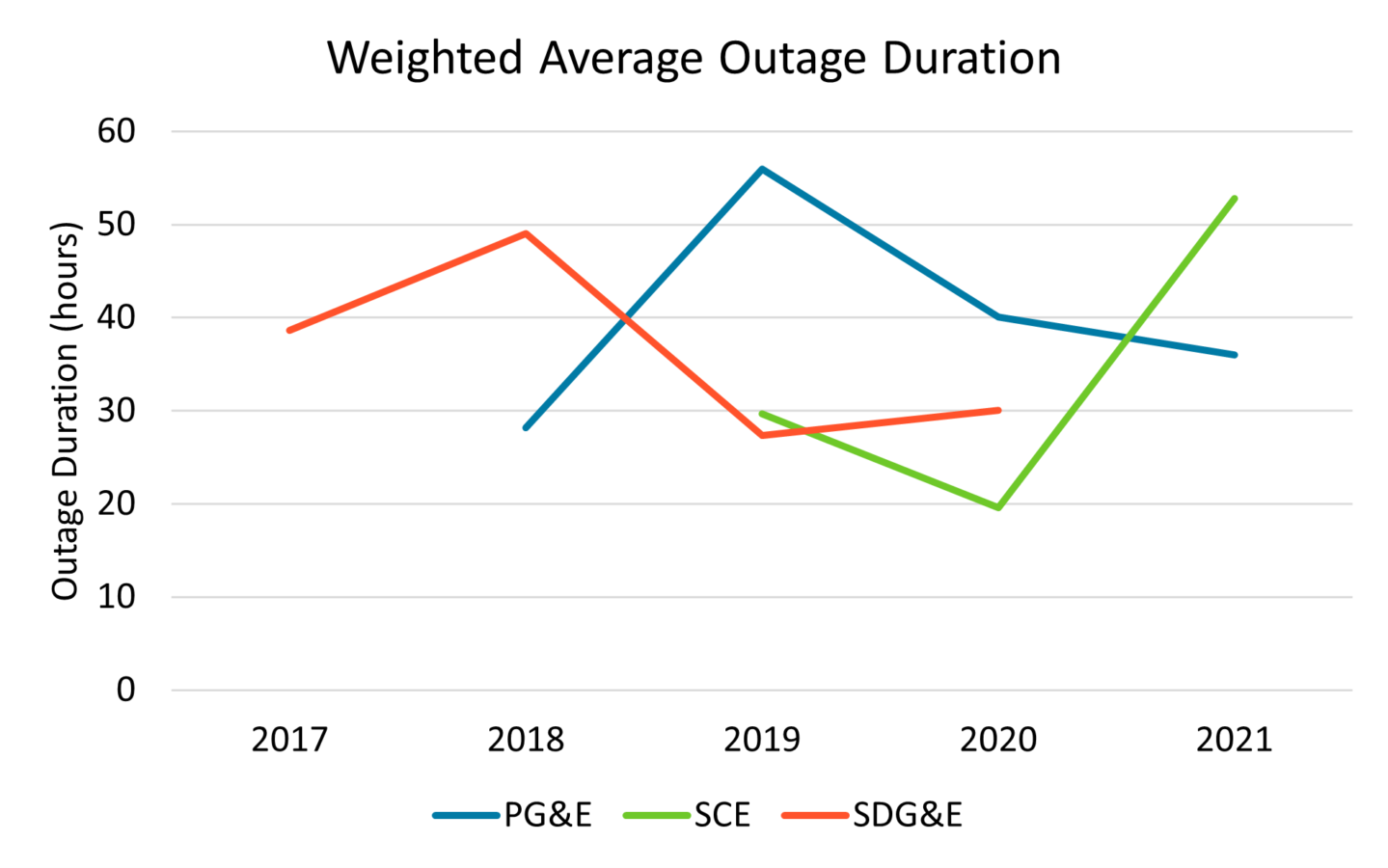It was only a few years ago when millions of Californians had their power shut off to prevent grid infrastructure from sparking wildfires. It was 2019, and California’s largest utility, Pacific Gas and Electric (PG&E), wasn’t taking any chances. Just a year before, its equipment ignited the Camp Fire, the deadliest fire in California history, and PG&E went into bankruptcy in January 2019 due to the mounting costs of wildfire damage.
No one seemed to know if power outages for millions was the new normal, or if California’s utilities would get better at reducing their risk of triggering wildfires without turning off power for so many customers.
The practice of shutting off power to prevent utility equipment from starting wildfires, commonly referenced as “public safety power shutoffs” or PSPS, has been much less prevalent in the news recently. But is that because PSPS events are now happening much less frequently, or have Californians simply become accustomed to these power outages?
I went looking for answers. And luckily, I didn’t have to look very hard.
California regulators have comprehensive shutoff data
As it turns out, the California Public Utilities Commission collects and compiles data on public safety power shutoffs, and the commission makes it publicly available in a handy spreadsheet for energy nerds like me.
This spreadsheet has all the information I was looking for: critical variables such as the number of customers impacted, the duration of each power outage, and much more. The data set spans a significant time range, from October 2013 through October 2021. It isn’t perfect, but it’s enough to show the trends and answer my questions.
Without further ado, here’s what I found.
No. 1: PSPS have impacted far fewer people since 2019
The first thing I wanted to know was how many people are being affected by shutoff events and how that’s changed over the years. After plotting the data, it wasn’t hard to see the trend.
The number of customers impacted by PG&E PSPS events skyrocketed in 2019, totaling 2 million over the course of the year. But it dropped almost as sharply in 2020 and 2021.
For Southern California Edison (SCE) and San Diego Gas & Electric (SDG&E), the picture is a little different. Those utilities have never cut off power to nearly as many customers as PG&E, but the number of their customers affected by shutoff events has slowly increased over the years, peaking in 2020.
Overall, I’m happy to report that 2019 does appear to have been an anomaly. PSPS events have affected far fewer Californians since 2019. But does that mean shutoff events are nothing to worry about anymore?

The total number of customers impacted by PSPS events peaked in 2019 when 2 million PG&E customers lost power over the course of the year. Since then, the number of impacted customers has fallen significantly, though recent trends may shift when PSPS data becomes available for November and December 2021. Note that “customer” refers to a household or a business, so the actual number of people affected by shutoff events far exceeds the numbers shown above. However, the data double-count customers affected by more than one PSPS event (i.e. if one customer experiences three PSPS events in one year, this data counts them as three customers). And for the ultimate energy nerds out there: The graph of (customers impacted)*(outage hours), a better but less understandable metric, shows an identical trend.
No. 2: Shutoff events are stubbornly long
Even though the number of people impacted by PSPS events has been declining since 2019, these outages still impact hundreds of thousands of Californians. And they can last a really, really long time.
The duration of these power outages hasn’t changed much over the past few years. On average, PSPS outages last one to two days, and there aren’t any obvious signs that shutoff events are getting shorter.
That means that hundreds of thousands of Californians are still losing power for days at a time. That means refrigerators full of food going bad, businesses unable to operate, people suffering through high temperatures without air conditioning, and folks who rely on electrically powered medical devices searching for power to stay alive.

On average, PSPS events have lasted one to two days, and their duration has remained roughly steady over the past few years. Note that the weighted average outage duration was calculated by summing (customers impacted)*(outage hours) then dividing by the sum of customers impacted.
No. 3: PSPS events impact the same people over and over
Another important finding, and the most alarming to me, is that shutoff events impact the same people and communities repeatedly. Of course, many of these communities are located in the wildland-urban interface, where wildfire risk is very high due to a variety of reasons, and utilities have turned to power shutoffs to manage the risk. The data collected by the California Public Utilities Commission includes information about which circuits utilities have turned off in PSPS events, and this information can be used as a proxy to determine when PSPS events continue to affect the same people over and over.
For example, PG&E de-energized the “Big Bend 1101” circuit six times in 2019, five times in 2020, and two times in 2021 (as of October 2021). It’s likely that the same 200 or so customers lost power each time that circuit got shut off, and most of those outages were one to two days long, but one lasted four full days. (Incidentally, it turned out that the Big Bend 1101 circuit ignited the “Camp B Fire” in 2018, which was consumed by the main Camp Fire.)
All that to say, PSPS events aren’t distributed evenly. While many Californians don’t experience them at all, some communities suffer them repeatedly over the course of a year.
The trends are positive, but there’s still work to do
Overall, shutoff events have been affecting fewer customers since the shocking number of outages in 2019. California’s utilities, especially PG&E, have clearly improved their PSPS practices. For example, PG&E has indicated that grid sectionalization devices have played a big role in reducing the number of customers impacted by PSPS events by enabling PG&E to turn off power only to discrete parts of the grid at the highest risk (e.g., see page 86 of this 2021 PSPS report).
That said, there are still major challenges. There are solutions out there, but they aren’t one-size-fits-all.
Grid sectionalization has proven itself useful in minimizing PSPS impacts, but it doesn’t always eliminate them entirely. To reduce the risk of live transmission lines starting fires, it is critical that utilities trim trees to avoid contact in the first place. But in the event that something does come into contact with power lines, simple technologies such as insulated power lines and more complex technologies such as synchrophasor sensors can prevent sparks from flying. In some cases, it may make sense to bury power lines underground, despite the high cost. And for some communities, microgrids or backup generation may be appropriate solutions to ensure the lights stay on (at least at critical facilities) when utilities shut off power lines.
Whatever the case, PSPS events are still having a huge impact on too many Californians. And even with all the power shutoffs, California utilities have continued to spark devastating wildfires, including the 2021 Dixie Fire, the state’s second-largest wildfire in history.
As we look ahead to a future in which climate change continues to exacerbate California’s wildfire risk, the state’s utilities still have a long way to go to prevent wildfires. Simultaneously, to fight climate change, Californians will increasingly rely on electricity—for transportation and home heating—instead of fossil fuels. This increased reliance on the electricity grid means there’s still a lot of work to do to ensure a reliable and safe grid for every Californian.

